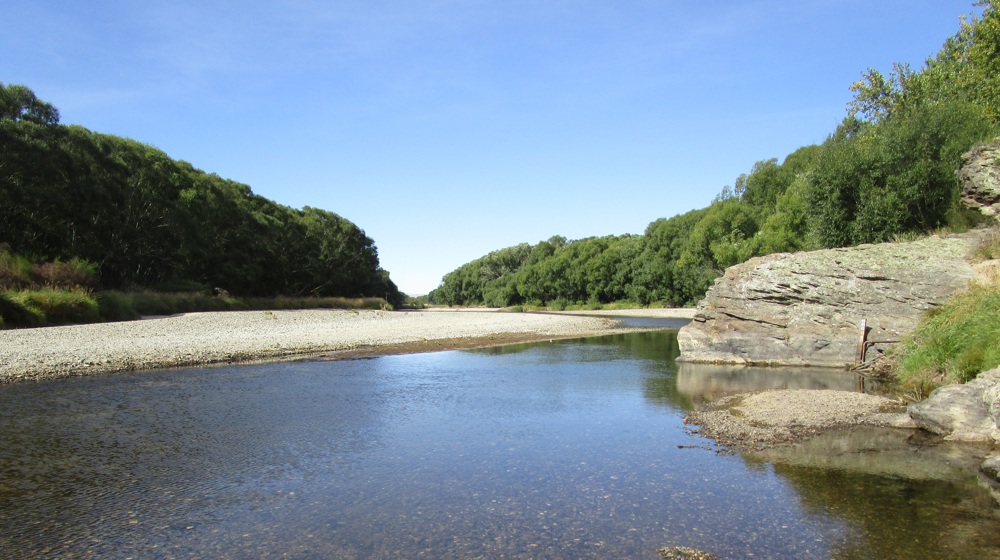The use of water from streams and rivers in some areas around Otago are already facing a variety of water restrictions, says ORC’s Manager Science, Tom Dyer.
“We acknowledge that for some communities this will be a difficult time, as people will be starting to feel the effects of the dry weather, leading into Autumn,” he says.
He says NIWA’s 35-day weather outlook suggests a continuation of recent similar conditions – more unsettled weather with some occasional rain - but with the potential for continued moisture-sapping hot dry windy spells in between.
“Many of our rivers are bouncing in and out of low flow conditions this summer due to the variable weather conditions,” Mr Dyer says.
While the NIWA forecast does not indicate an escalation in drought severity, it suggests continued dry conditions overall, with the effects most keenly felt in Central Otago and North Otago, Mr Dyer says.
A MetService forecast yesterday noted that while there may be rain for the South Island’s east coast this week, the accumulations will not be expected alleviate the dry conditions.
“We’re encourage farmers to make plans and take action early with regards to stock feed and to reach out early for support and advice,” Mr Dyer says.
Mr Dyer says consent holders and catchment groups are doing a good job, which has so far avoided the need for ORC to consider introducing water shortage directions. He notes that when minimum flows are hit, consent holders must cease taking water.
Mr Dyer says for the most part, waters users compliance with the rules for their waterway has been “outstanding” so far this year.
Waterways around Otago
The Taieri and Manuherekia rivers are at low levels and are still being used for irrigation with users managing flows with combined storage and restrictions to achieve their respective minimum flow regimes, he says.
ORC staff have been in contact with users in the Manuherekia Catchment.
Mr Dyer says Falls Dam is now at low levels and many users are moving to 25% restrictions this week.
“Staff will be monitoring water take data and ecological conditions to ensure river flows are kept to a sustainable level. Further restrictions may yet be required,” Mr Dyer cautioned.
In the Taieri, some water users that take from the river and its tributaries are facing restrictions as river flows drop, although irrigation company dam levels are still relatively high.
 Sheep in dry summer drought conditions
Sheep in dry summer drought conditions
In North Otago The Shag - Waihemo has been below its minimum flow since late January and irrigation has ceased accordingly.
The Waianakarua dropped below its minimum flow in mid-February and irrigation has ceased.
Mr Dyer says both those rivers are still used for domestic water supplies and stock water. Irrigation can still occur where stored water is available.
“ORC staff have been monitoring water takes and in regular dialogue with users when minimum flows are triggered. Staff will be making contact with Shag-Waihemo water users this week to try to understand their current stock numbers and water demand, because if the dry conditions continue further restrictions may be required,” he says.
In South Otago, Mr Dyer says the Waiwera, Pomahaka and Waitahuna rivers have been low for short periods, but those catchments have received greater rainfall more regularly than those in North and Central Otago.
He says ORC staff are still monitoring rivers and consented takes to ensure the waterways are protected for all.
QLDC and central Government preparations Last Friday Queenstown Lakes District Council reinstated level 1 water restrictions for Luggate, following prolonged dry conditions and an increase in demand.
Level 1 water restrictions also remain in place for Hāwea and Arthurs Point.
QLDC Operations Manager Simon Mason says level 1 restrictions requires residents and visitors to keep hand-held hosing to a minimum, and to only use irrigation sprinklers between midnight and 6am, when general demand is at its lowest.
“We have observed extended periods where water is being drawn from the reservoir faster than we can replace it which obviously isn’t sustainable. By taking a few simple steps now everyone can help ensure the network remains in good shape, especially with continuing hot weather,” said Mr Mason.
Agriculture Minister Todd McClay said last Friday the coalition Government was providing support for farmers and growers as dry conditions worsen across the top of the South Island.
“Conditions on the ground across the Marlborough, Tasman, and Nelson districts are now extremely dry and likely to get worse in the coming months,” Mr McClay said.
“Funding of up to $20,000 will be made available to the Top of the South Rural Support Trust to plan for events and support farmers and growers where needed.
“The top of the South Island is not in meteorological drought, but this step will ensure early support is available for farmers, growers, and rural communities,” he said in a release.
Good practice tips for conserving water during dry conditions - ORC
- Check for leaks around stockwater and irrigation infrastructure
- Irrigate at times when the water is more likely to be absorbed
- Apply irrigation so that it is retained in the pasture or crop root zone - for more tips, check this Irrigation NZ factsheet
- If you are unsure if your irrigator is applying the right amount of water, our Catchment Advisors can help you carry out a bucket test.
- Please email catchments@orc.govt.nz to find out more.
- Minimise water use on gardens and lawns
- Don’t leave water running unnecessarily
- Avoid washing vehicles and boats
For more information on low flows in Otago’s monitoring sites, please go to https://www.orc.govt.nz/managing-our-environment/water/water-monitoring-and-alerts;
Visit ORC’s new Environmental Data Portal for the latest water flow levels
Questions or concerns? Email compliance@orc.govt.nz

